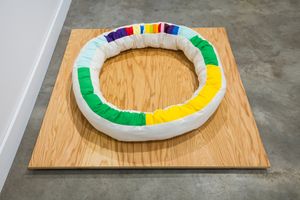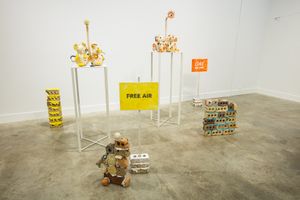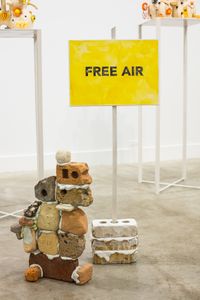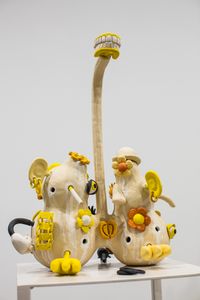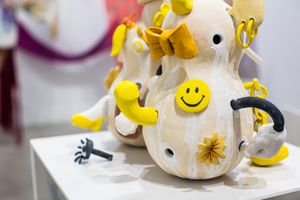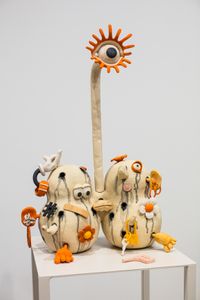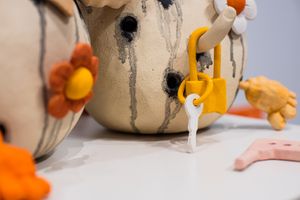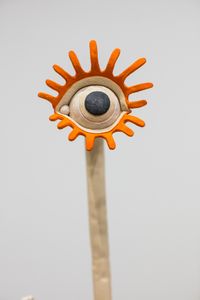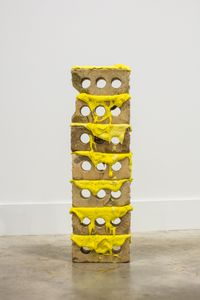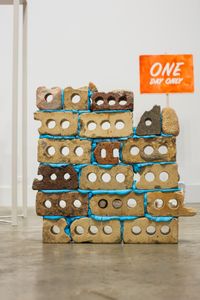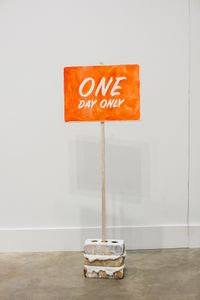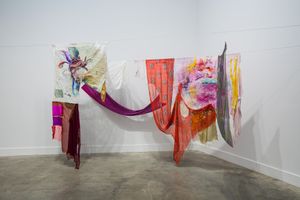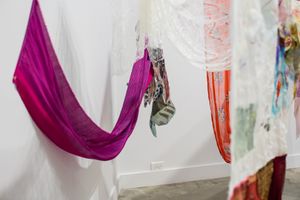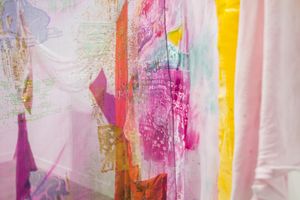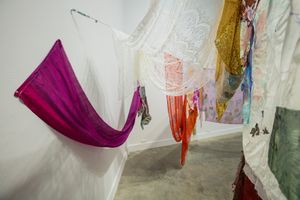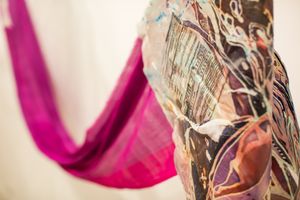The Contemporary Austin's Crit Group 2020
- Exhibition Dates: November 14 - December 13, 2020
- Gallery Hours: By appointment
Featuring: Annie Arnold, Rakhee Jain Desai, Lydia Garcia, Sean Ripple, Alexandra Robinson, Saul Jerome E. San Juan, Michael Stephen, and Cheyenne Weaver
The Contemporary Austin and grayDUCK Gallery are pleased to present the exhibition Crit Group 2020, featuring work by eight artists who participated all year in the museum's Crit Group—a program that combines group critique with professional development to support the holistic artistic practice of local artists. Now in its seventh year, the program aspires to build a supportive community of Austin artists and to strengthen their practices with input from each other and established professionals in the field. In the past, program participants met monthly over nine months for discussions and group critique of new work in progress, culminating in an exhibition. Despite the challenges 2020 posed, this year’s participating artists willingly extended their commitments to the program and each other an additional three months—an inspiring example of the resilience of the creative community.
The culmination of this year’s Crit Group program, the exhibition includes a diverse range of sculpture, installation, textiles, photography, video, and painting. Dynamic and relevant, it features work by these eight talented Austin-based artists who challenged themselves to grow their art practices in new ways and respond to the current moment: Annie Arnold, Rakhee Jain Desai, Lydia Garcia, Sean Ripple, Alexandra Robinson, Saul Jerome E. San Juan, Michael Stephen, and Cheyenne Weaver.
The artists were each invited to participate in the program for a variety of reasons based on the range of their artistic development, moment in their career, and the overall composition of the group. While their art takes distinct forms, a number of themes—including cultural identity, the significance of place, and contemporary issues—have emerged and unite their group exhibition. Rakhee Jain Desai’s interest in telling South Asian immigrant stories led to painting and dying her family’s heirloom saris, then sculpting vivid fabric installations. Cheyenne Weaver’s gathering of toy-like ceramic characters, painted signs, and brick sculptures evoke collective movements to breakdown and rebuild contemporary culture. Alexandra Robinson’s color-coded flags and soft sculptures map her military family’s heritages by using symbolic coding and pageantry. Saul Jerome E. San Juan makes multiple portraits of men he encounters in both virtual and physical public spheres that reflect on desires and stereotypes that have impacted his sense of self and belonging. Annie Arnold patches and embroiders textile wall hangings with humorous texts she draws from status symbols and social media personas. Sean Ripple’s developing online video adapts with participants’ content to test technology’s rapid ability to divide yet connect people. With a different relationship to time, Lydia Garcia gathers local organic materials into the gallery, regularly sharing her experimentations, observations, and paintings using natural pigments in a slowly evolving installation akin to her studio practice. Michael Stephen transforms an array of materials for his meticulously crafted sculptural installations to wonder about the ‘90s pop culture of his youth and the mysteries of our uncertain futures.
While Crit Group 2020 is diverse, each artist is connected by an intense desire to hone his or her artistic practice, a rigorous investigation of the creative process, and support for an artistic community in this moment. More information about each artist and the program can be found at thecontemporaryaustin.org and at grayduckgallery.com.
CRIT GROUP AT THE CONTEMPORARY AUSTIN
Launched seven years ago and now with fifty-nine artist alumni, Crit Group at The Contemporary Austin brings together emerging and established Austin artists to facilitate the growth of their complete artistic practice. Participating artists attend monthly sessions, informal gatherings, and studio visits while receiving group feedback on works in progress. The group also discusses professional development topics such as writing effective artist statements, bios, and proposals; applying for grants and residencies; and what to expect from curators and art dealers. An off-site group exhibition and public artist talk round out the program. Crit Group is organized by Andrea Mellard, Director of Public Programs & Community Engagement at The Contemporary Austin, with co-leaders Sterling Allen and Annette DiMeo Carlozzi.
Offered free to selected applicants, Crit Group extends the reach of The Contemporary Austin’s vibrant educational initiatives, providing valuable continuing education experiences for professional artists and strengthening the contemporary art community as a whole.
Crit Group program was created and continually adapted in direct response to artists’ feedback. In 2021, the program will pause to assess the best ways the museum can serve local artists in a moment characterized by changes. More information about the program and all fifty-nine past participating artists at thecontemporaryaustin.org/explore/for-artists.
THE CONTEMPORARY AUSTIN
As Austin's only museum solely focused on contemporary artists and their work, The Contemporary Austin offers exhibitions, educational opportunities, and events that start conversations and fuel the city's creative spirit. Known for artist-centric exhibitions and collaborations, The Contemporary invites exploration at both its urban and natural settings—downtown at the Jones Center (700 Congress Avenue), lakeside at the Laguna Gloria campus (3809 West 35th Street), and around Austin through the Museum Without Walls program.
CRIT GROUP CO-FACILITATORS AND EXHIBITION CURATORS
Sterling Allen holds an MFA in Sculpture from the Milton Avery Graduate School of Arts at Bard College. Allen is a co-founder and co-director of Okay Mountain, an artist collective and former gallery based in Austin, Texas. As a solo artist and in collaboration with the group, Allen has exhibited, organized, and completed projects at venues throughout the United States and received several residencies including the Artpace International Artist-In-Residence Program in San Antonio, Texas and a residency at the Bemis Center for Contemporary Arts in Omaha, NE. He has exhibited at numerous venues including the Contemporary Arts Museum Houston, Utah Museum of Contemporary Art, Salt Lake City, UT, the Southeastern Center for Contemporary Art, Winston-Salem, NC, and VOLTA NY. He has been twice nominated for an Art Matters Grant and was recently awarded a Rauschenberg Foundation Residency. He is currently an Assistant Professor at Texas State University where he teaches Sculpture and is acting Area Coordinator in Foundations.
A champion of local artist communities who stays abreast of international developments, Annette DiMeo Carlozzi has a keen eye for emerging talent and a steadfast commitment to looking beyond labels. Building an expansive practice as a curator of modern and contemporary art, she has created seminal exhibitions, produced important commissions, and acquired major works by a wide range of artists for curatorial and directorial posts in Minneapolis, Aspen, New Orleans, Atlanta, and Austin. Named to the Austin Arts Hall of Fame in 2013, she has served as a consultant, adviser, board member, and/or panelist for over fifty organizations including Creative Capital, Artpace, and UT’s Division of Diversity and Community Engagement. After a long, institution-based career, Carlozzi is now an independent curator and will open a new exhibition of Texas-based artists' works--After Carolee: Tender and Fierce--at Artpace, San Antonio in early 2021.
Andrea Mellard is Director of Public Programs & Community Engagement for The Contemporary Austin and founder of Crit Group. She curates programming that takes advantage of the museum’s two distinct sites—one urban and the other natural—and provides platforms for audiences to come together, investigate art, and create new experiences. In addition to film series and artist talks, Mellard has curated recent exhibitions and projects with Janine Antoni, Sanford Biggers, Nick Cave, Abraham Cruzvillegas, Lucky Dragons, Ragnar Kjartansson, and Mark Mothersbaugh. She has worked with a multitude of emerging Texas artists for the New Art in Austin, Texas Prize and New Works exhibition programs (both at the formerly named Austin Museum of Art and AMOA-Arthouse). She has over nineteen years of museum experience, and an MA in American Studies from The University of Texas at Austin inflects her interdisciplinary approach to contemporary culture.
Artist statements and bios
Annie Arnold
I’m bemused by the social and cultural phenomena of widespread narcissism. How is it that much of what passes as “self-esteem” in our current times is actually a mindset that normalizes vanity and ostentation? In response to the overabundance of self-serving behaviors, I use humor to encourage critical mindfulness about the banal minutiae and myopic value systems celebrated by our culture. Truly, what makes self-congratulations such an alluring & popular message?
Through the rich visual language of the leisure arts; cross-stitch, quilting, crochet, etc., my current body of work draws parallels to digital output; between handiwork and social media. I’m making visual connections between the ways we now choose to spend time and build community versus how we’ve done so in the past. The process of crafting an image online is its own artform, and impression management requires a significant investment of time. My work explores these expenditures and manifestations as a reflection of value(s).
In this exhibition, I pair found text with embroidered patches I designed from posted social media photos. Referencing Girl and Boy Scout sashes, letter jackets, and virtual badge reward programs, these works serve as identifiers, tokens, souvenirs, credentials, and accolades. To quote John Fairchild, founder of W magazine, “Empathy and envy are what drive social behavior.” But it’s the immortal words of Willie Nelson that really get me thinking, “Is [our] head up [our] ass so far [we] can’t pull it out?”
Annie Arnold is a visual artist interested in cultural trends related to narcissism. Using a variety of media, she explores narcissistic practices, including methods for getting attention, impression management, the pursuit of social advancement, and the purveyance of “good taste.”
Arnold is currently a participant in The Contemporary Austin’s Crit Group program. In 2012, her project Needed Fabulousness took her to New York Fashion Week, and she has been included in numerous group exhibitions, including the exhibition-in-print, New American Paintings.
Arnold earned her Masters of Fine Arts from the College of Visual Arts and Design at the University of North Texas, Denton, and her Bachelors of Art in Studio Art from the University of Texas at Austin. She currently lives and works in Austin, Texas.
Rakhee Jain Desai
In a time when freedom, truth and liberty are all personally questionable, I feel compelled to tell my story: the story of my mother who migrated to the USA for the American dream, my Indian American female identity and those who came before me. Through 2020 and the Crit Group, I gained the confidence to push my art into a space that feels raw and unexpected. This installation work combines Batiked and turmeric-dyed fabrics, text and images transfers with colorful textiles from my family’s collection in a way that I have not done before. As my parents age and the connection to my motherland fades, the worn textiles are now relics of my ancestry and memories. I remember stories of my heritage through the remnants that my mother has held onto over the last 50 years such as her engagement saree or sarees that my grandmother gifted her on momentous occasions. Through her sewing scraps from my childhood clothes, I recollect memories of my upbringing. As I work through the complexities of South Asian American women in our current time, I also work through my worries as a mother of two young girls.
The work’s intersecting panels and storylines cannot be viewed in isolation and much like everything else, must be seen as overlapping, complex layers to be fully understood. Draped, softly sculpted and suspended, these paintings are immersive and multisensory, encouraging the viewer to experience it from all angles, walking among or even underneath, moving about the space in an intimate conversation with the installation.
Rakhee Jain Desai is an interdisciplinary artist whose work creates dialogue about immigrant identity and belonging. Her current body of work utilizes the centuries-old, wax-resist textile technique, Batik. The combination of Batik, an Eastern craft, with traditionally Western mediums (encaustic, oils and acrylics) is a signature process that aptly communicates her South Asian American identity.
Her work, A Place to Call Home, 2018, for the City of Austin Art In Public Places (Tempo2D program) integrates the stories, hopes and aspirations for new immigrants in Austin, Texas. The Batik mural named A Place To Call Home is now on permanent view at the Austin Bergstrom International Airport.
Lydia Garcia
My studio is a space of shared exploration. Filled with piles of foraged materials and tools (jars, bottles, paper, plexiglass, liquids, metals, etc.) I frequently grab as I work, I mindfully select, harvest, and process materials, intimately connecting the actions of cooking with the act of ritual. There is a violence in the destruction of materials inherent in the creating process. Time is a dictator, and the fretting and reconciliation that happens when creating temporal materials, knowing their fragility, is a constant consideration and theme throughout my work.
My contribution presented here, in grayDUCK Gallery, is a process-based residency that reflects the experimental exploration of creating colors and sculptural forms utilizing natural inks and pigments. Using collected ingredients from various locations, I laboriously cook, grind, and blend; using traditional materials and methods of ink making, from natural dyeing to fermentation; to create new textures and organic colors. Even though my techniques are calculated and perfected, accidental magic throughout the process is key to my research. As colors shift as a result of time, or an unknown oxidation within an ingredient leaves an uncanny surprise, it is this uncertainty that excites and ignites my studio practice.
Lydia Garcia is a Central Texas-based visual artist whose works explore the character of organic materials and the human behaviors that alter their landscapes. Creating raw pigments, handmade colors, and layered textures through a process of experimentation, Garcia produces organic formations that break down, interact and shift. Using her training in painting, video, and light, she renders these abstract forms utilizing various substrates. In a larger sense, Garcia is interested in temporal limitations on organic materials such as plants, geological forms, and natural chemicals. Location is paramount in terms of ownership, care, and societal structures focused on land ownership.
Searching and collecting various ingredients is an important element to Garcia’s practice. From black walnut hulls in an Austin backyard, beets from local farmer’s markets, dirt off highway 71, or copper yen from Japan, Garcia’s selected materials range from local to international spaces and environments.
This studio process has led to the establishment of Ochre & Iron, an evolving social practice in which Garcia shares and exchanges knowledge and services through interactive workshops, process-based exchanges, and community involvement, while generating working materials native to the Central Texas region.
Sean Ripple
Sean Ripple (born 1975 in Austin, TX) is a conceptual artist. His projects are often improvisational and interventionist in nature and rely heavily on social media and the internet to frame the outcomes of a feverish dedication to an idea. His approach is informed by music video television programming from the ‘80s and ‘90s, the DIY approach of mid-‘90s lo-fi/punk rock culture, early mainstream internet culture, film, advertising, and administrative processes. Recent works have explored a perceived lack of interest in participating in and contributing to interactive projects across a number of digital platforms as well as a destabilization of meaning that seems to trail technological innovation and advancement. His work has been featured in regional publications including …might be good, Glasstire, Austin American Statesman, and Conflict of Interest. Recent exhibitions include Lossy Process at Co-Lab Projects (2019) and illiterate – a bookstore… an exhibition at Pump Project (2017). He holds a BA in Organizational Communication from St. Edward's University.
Alexandra Robinson
In my recent work I explore identity by using coded languages as an indecipherable syntax. I am interested in the probability of misinterpretation of information. This exchange can generate a multitude of meanings – some unheard or misheard, from cultural, geographical or political points of view. Referencing Stuart Hall’s encoding and decoding model, I am intent on passing coded information to my audience. These messages can be decoded and translated, but more often they won’t, and instead the form with which the language is shared is decoded. I am specifically interested in the act of receiving and deciphering because so much of how one thinks about identity and place exists within abstractions and symbols. Through declarations (labels, data, and patterns) information is accessible but purposely difficult to access. It is in this space of translation that I find the purpose of the work.
I have explored these ideas through Morse code, flag semaphore and the flag form itself. Objects, when scaled to specific sizes, conjure ideas of nation, place, and become representative of identity. A relationship to power is also constructed when one considers who historically has used these forms of encoding, in this case the U.S. Military (a structure within which I grew up). By presenting a language that is possible to translate, I am setting up a dividing line, a place of borders. I take inspiration from Gloria Anzaldúa’s Borderlands/La Frontera, in which she explores borders in language, location and culture. It is in the friction of two worlds, una herida abierta (the open wound), where one world grates against the first and bleeds, that a third is created. The work I am making is expressive of this friction and the placelessness of language, culture, and identity is in a constant state of transition. I am seeking out my own plurality of place and identity in the space in which my heritage has been repressed, displaced or traded for other identities.
Alexandra Robinson is a visual artist who uses coded language and symbols to explore ideas of identity and place. She grew up in the military with her immediate family; an intersection of her Mexican and Jewish heritages. Robinson was a child of worlds in which histories, language and religion were repressed or traded for other identities and it is these themes that continually inform her work. She received her MFA from the University of Cincinnati in Ohio and currently teaches at St. Edward's University in Austin where she is an Associate Professor of Art. Robinson lives with her husband and two daughters and has exhibited throughout the country and internationally.
Saul Jerome E. San Juan
Oil Paintings Prior to Crit Group: In the series of paintings of photoshoots I have conducted with blue-eyed men since the spring of 2016, the physical absence of my favorite color embodies desire. Blue is my favorite color. I love water and the hot clear skies of the Texas summer, as I am drawn both to the tender innocence and the menacing coldness of blue eyes. I have relied on tricks of color theory and cultural bias to make my favorite color appear to the beholder. The coolest color in the palette is a mix of carbon black and titanium white, two “non-colors” pitted against the heat of red and yellow. In the real world, blue eyes, after all, are not the result of blue pigments, but rather the lack of warm pigments found in green, hazel, and brown eyes.
Experimenting with Cyanotypes during Crit Group: From willfully avoiding blue pigments in my main body of work prior to my first Crit Group session in March, I go to the pervading blueness of cyanotype. Having first learned of the existence of cyanotype as a medium when I caught the last weekend of Sarah Fox's show in December 2019, I exposed and developed my first successful cyanotype on August 1, 2020, a full decade after I began avoiding blue in my paintings in summer 2010.
The history of cyanotype as a medium for the reproduction of imagery in multiples like architectural blueprints reinforced my choice to return to my practice of appropriating found digital imagery as a practical solution to not being able to conduct photoshoots. The subject depicted in Sunnnn is someone who I first encountered on Instagram and had intended to photograph as part of the series of paintings of blue-eyed men.
Born in the Philippines in 1983, Saul Jerome E. San Juan moved to the USA at age fourteen with his mother and two younger siblings. After studying art and music as an undergraduate at Loyola in Chicago, San Juan came to Austin in 2007 to complete a graduate degree in architecture at the University of Texas.
San Juan’s art has entered the spaces of public consumption through the Neill-Cochran House Museum, The Georgetown Art Center, The People’s Gallery at Austin City Hall, Austin-Bergstrom International Airport, Build Hope Not Walls at Big Medium Gallery, Northern-Southern Gallery, Vault Stone Shop. and the LINE Residency.
San Juan enjoys engaging others, especially school-age children, through participatory art-making, volunteering in endeavors such as the Dell Children’s Medical Center Art of Giving and the Austin Police Department Summer Youth Leadership Program. These community endeavors have inspired San Juan to pursue an official Texas educator certification, beginning his new career as an art teacher at Stephen F. Austin High School in August 2020.
As both a classroom educator and an artist with an active art practice, San Juan hopes to contribute holistically to our society today and tomorrow the sublime empathy that art has the potential to inspire in people of all ages and diverse backgrounds.
Michael Stephen
Our attraction to objects is often mysterious — whether they are significant, symbolic, or banal, makes a lasting impression on us that we don’t always notice. In sculpture and installation, my works use a variety of carefully considered, collected, and at times alchemically altered objects. Cloaked in a psychotronic aesthetic of popular culture, these images, objects and cast materials (the VHS, deadstock Nike Decades; pocket lint,) are sourced to generate new autonomous relics. These relics seek to archive the complex visual experience of the American cultural landscape while invoking our idiosyncratic relationships with nostalgia, consumerism, ritual, causality and transformation.
Even though not all the objects in my work may be recognizable or even tangible, they conjure an affective engagement. It is in this zone of attraction and affect where my works reveal the omen in the ordinary.
Michael E. Stephen is a conceptual artist working in the expanded field of sculpture. His objects and arrangements, composed from appropriated to alchemically cast materials, seek to unveil the dynamism of objects as they pass through time and space. Context is critical as these objects work to archive our idiosyncratic relationship with nostalgia and the act of the ritual. Stephen’s minimally aesthetic forms display his mystic reverence for psychotronic groupings, object-oriented ontologies, and obsolescent territories.
He received his BFA at the University of Texas at Tyler and his MFA at the University of Oregon. His work has been exhibited in various national and international venues such as New York, Los Angeles, Portland, OR., Miami, Norway and Italy. Michael E. Stephen currently lives and works in Los Angeles, CA.
Cheyenne Weaver
My work seeks to unearth histories that have been forgotten or whitewashed using that earth--as a poetic alchemy of material evidence. This body of work is a reflection on the labor and vulnerability required to understand my own complicity in these erasures. Through the material of place, I expose the absurdity and fragility of the subsequent void.
The narrative of materials is critical to my work. Both figurative sculptures are a reflection on two white supremacy cultural characteristics--Perfectionism drips with a lime whitewash, traditionally used as a disinfectant paint, made of local limestone. While Centering leaks mascara and rainwater, collected from Summer storms that brought in dust from the Sahara. These materials clash with ornaments and signage of absurd and colorful commercial cultural identity that first draw the viewer in and then, perhaps, suggest introspection or multiple readings. Sale, or protest?
Other work includes Butler, Elgin, and Seco brick I unearthed from West Bouldin Creek. The daily ritual of gathering bricks connected me, in a physical way, to the labor required for introspection. These bricks, made with local clay, were used to build many of the institutions and monuments of Austin’s whitewashed history. Bouldin Creek is named after Confederate Colonel James Bouldin who purportedly gave over some of his lands to his slaves after the Civil War. A Freedom Colony was established, yet has been erased without memorial. I believe we remain empty and fragile when we deny our history. A connection to the unique material fabric of place is critical to our survival, and we must do the hard labor, both inside and out, to rebuild our foundations.
Cheyenne Weaver was born in San Miguel de Allende, México, and grew up in the corporate suburbs of Austin, Texas. She received a BFA from CalArts in 2004 and a master’s in social design from AC4D in 2011. Her show at Big Medium in 2019 integrated hand-dug clay from various locations across the Southwest, from superfund sites to casino drainage ditches. Her work addresses the longing for a deeper connection with place and the systemic negation of place in contemporary commercial culture.
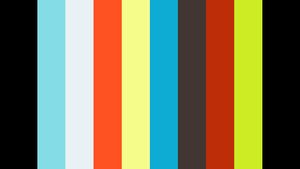
Annie Arnold - Crit Group 2020

Rakhee Jain Desai - Crit Group 2020

Lydia Garcia - Crit Group 2020

Sean Ripple - Crit Group 2020

Alexandra Robinson - Crit Group 2020

Michael Stephen - Crit Group 2020


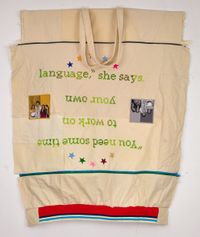
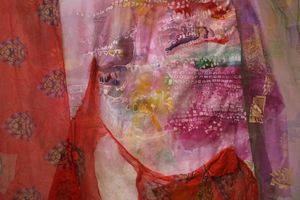
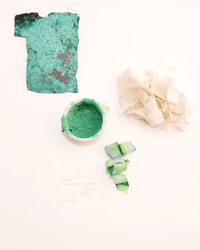
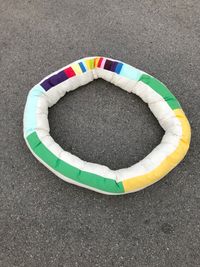
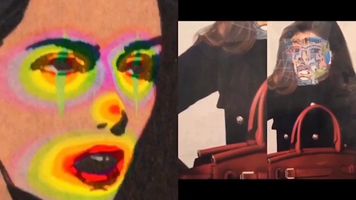
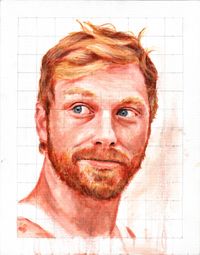
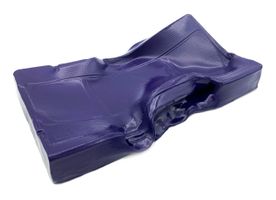
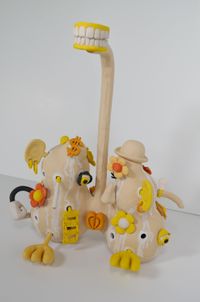
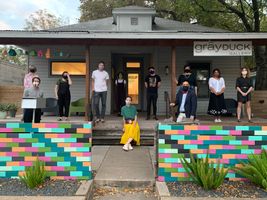
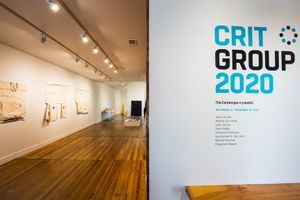
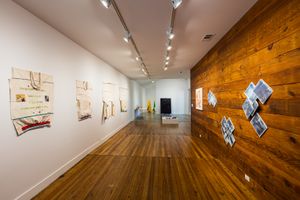
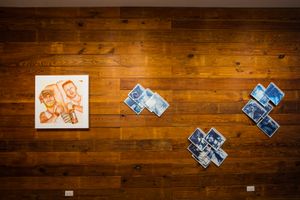
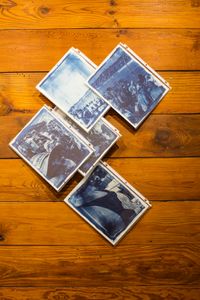
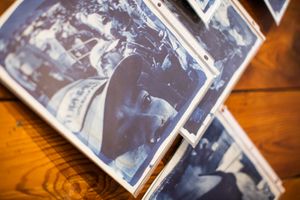
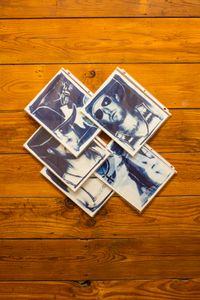
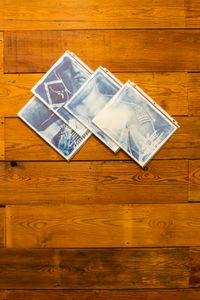
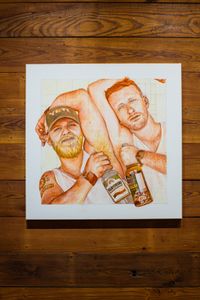
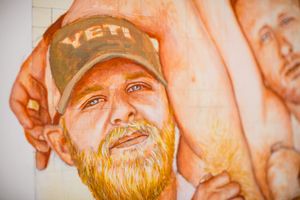
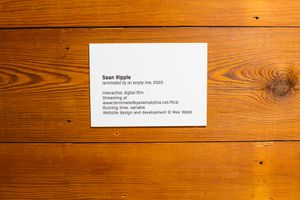
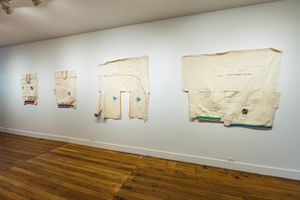
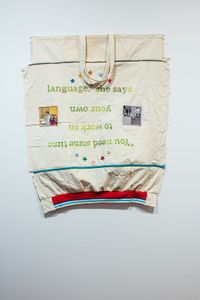
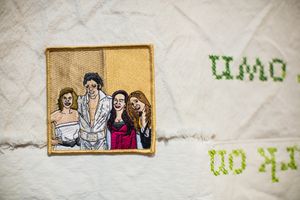
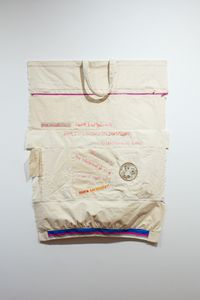
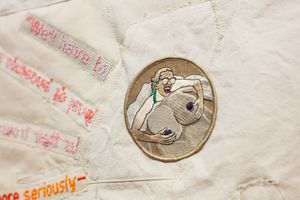
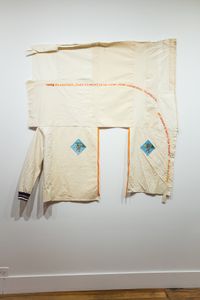
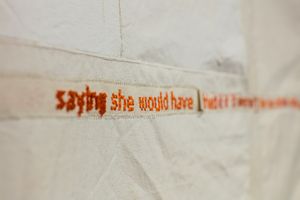
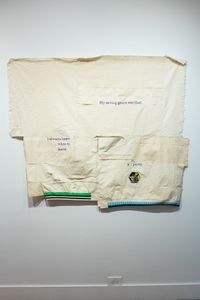
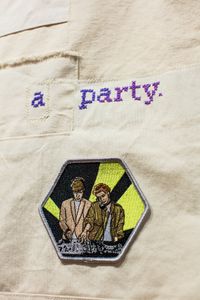
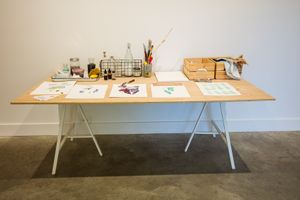
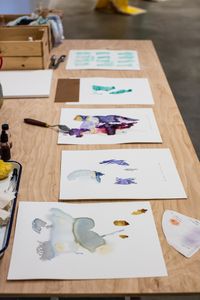
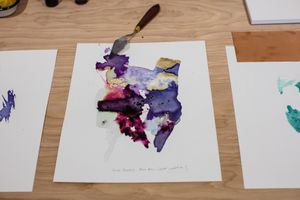
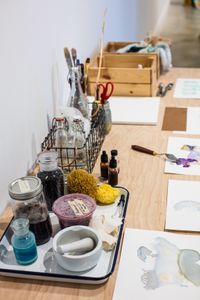
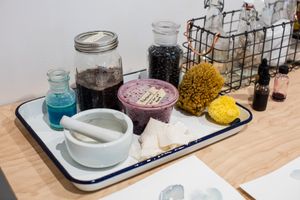
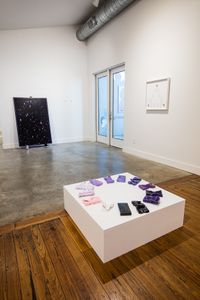
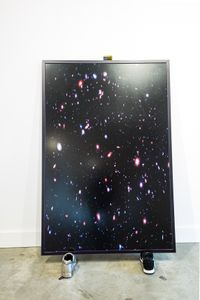
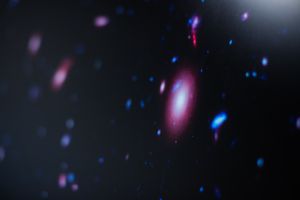
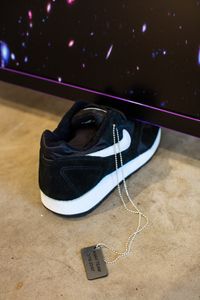
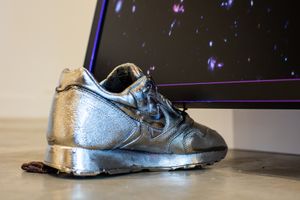
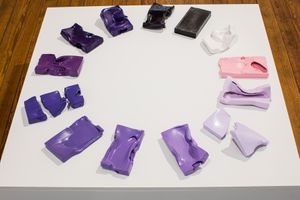
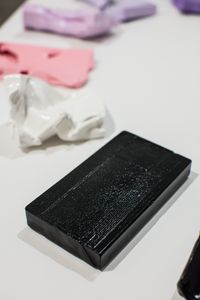
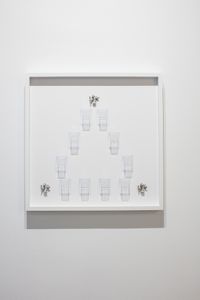
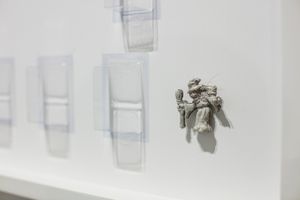
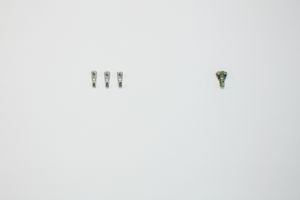
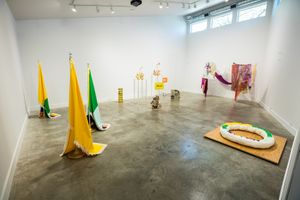
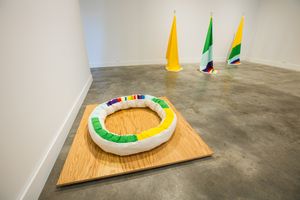
![Alexandra Robinson, 100% Authentic(ation) Flags 3 of 4 [father, mother, daughter]](https://static.spacecrafted.com/b1d3dc2c91914ea39d2f012f65491d58/i/d1b7be7b50ec4087a1c0b2c7f70948ba/1/4SoifmQpDrHbZJ6VvdPAk/crit%20group%20070.jpg)
